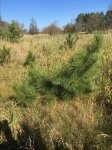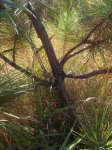@Relknes - nice, I once had a few seedling Pinus resinosa, for a number of years. Got bored with them and let them go. They developed too many faults for me to feel they were worth the trouble. I wasn't as knowledgeable about bonsai at that time, now I would only tackle P resinosa if I knew I had the time to do the yearly work on them that I now understand needs to be done. For what it is worth, I prefer their other ''common name'', American Red Pine, calling them Norway pines is confusing, because they are strictly a North American native species, though they have been used in forestry projects elsewhere in the word. I agree they have wonderful bark. I have some on the family owned farm in SW Michigan, and in spring, their pollen is bright red, which was startling to see. Totally cool but not a useful trait for bonsai.
Honestly, I think P. resinosa could make a decent medium to large bonsai, but if your trees are already 7 feet tall and 3 inches in diameter and you haven't done anything, the "ship may have already sailed" on turning them into bonsai.
I want to compliment you on "getting it", many do not actually follow through on the idea that you have to build a thick trunk first. as the first goal of growing a bonsai from scratch.
Field growing in general, root management is difficult. Most field grown trees are species that can be rooted from cuttings, meaning they are capable of regenerating a whole new root system when they are collected from the field. With pines that do not regenerate roots easily, they must have roots pruned, or possibly even be dug up, root pruned and replanted every 4 to 5 years to do root work to keep fine feeder roots close enough to the trunk so that they will fit in a bonsai pot when they are finally ready for a smaller pot. For best results I suggest no pruning of branches 6 months before and 12 months after digging up, root pruning and replanting. With single flush pines, the method most likely to not harm the tree is to either work the roots or work the branches, but never do both within a 12 month period. One insult only in any 12 month period. Note I did not say "in one year" because a hard prune in autumn 2015 and repotting in spring of 2016 is less than 6 months between "insults". Count the months, trees need time to recover, and root pruning is the most stressful activity we subject our trees to. Normally a tree in the wild will never have to deal with any major root disturbance at all, ever. Root pruning can be quite traumatic to a tree.
Branch management for pines in field development is critical. As you have seen, you need the leader to get to 7 feet to get a 3 inch diameter trunk. The trick with pines is you need to keep the lowest branches healthy, with needles still close to the trunk, in order to have branches to choose from when you style your tree. For pines, every year you prune back the lower branches, to keep them short and bushy, you remove the medium height branches to prevent them from shading out the low branches. You want your lowest branches to be in full sun all day. You let the leader grow long to thicken the trunk. A properly field grown pine for bonsai looks like a weird ball of foliage at ground level, a long bare stalk and a big explosion of foliage way up in the air.
@Adair M has some good photos of his field grown pines that would illustrate this nicely.
All may not be lost. Do these field pines still have branches with needles within 24 inches of the ground? If yes, you might be able to recover these for bonsai use. If not, then these are only good for landscape trees, niwaki or timber production. Generally for a finished tree, first branch is at 1/4th to 1/2 the total height, with the most common being at about 1/3rd the total height. So a first branch at 24 inches suggest the finished height will be somewhere between 4 and 6 feet tall. And a bonsai between 4 and 6 feet tall is at the larger end of the spectrum of bonsai sizes common to see in the USA.
In my experience P resinosa is a single flush of growth pine. This means training will be more like Pinus sylvestris or Pinus nigra, rather than like Pinus thunbergii. Its growth pattern is different from both Japanese black pine and Japanese white pine, so ignore all suggestion about when to do what from bonsai sites about those two species. Look specifically for articles about single flush pines. Pinus mugo is a single flush pine also, and Vance Wood has a number of good articles on this site, on how he grows his in Michigan. If you are in Michigan, I would consider using Vance's calendar for Mugo pines for when to do what to your Pinus resinosa. You are to some extent in uncharted waters with Pinus resinosa. So you will need to observe carefully how they respond to different things you do, take notes, and see what works, what doesn't and then let us know about how it went. (I'm at least curious).
About actually pruning your field pines, read these Japanese Black Pine articles on the Evergreen Gardenworks website. Brent Walston has written the best collection out there about growing trees from seed or nursery stock to the point where they are ready for their first bonsai styling. Remember his articles are about Japanese Black pines, which have two flushes of growth, so be conscious of the fact that your pines won't respond the same way, and you will need to find the Scotts pine articles & mugo articles to get a better idea about when to prune what. But Brent in his articles correctly talks about how to keep low branches healthy on pine seedlings being grown for bonsai. You do have it right, grow the trunk first. Brent follow up on that line of building a tree segment by segment from the ground up.
http://www.evergreengardenworks.com/articles.htm
If you have no branches less than 24 inches from the ground, you might still be able to graft branches that low, but this note is too long for that discussion. Post photos and my fellow BNutters can give you ideas of where you are at in the process.
Enough typing for now, hope this helps. - Leo




